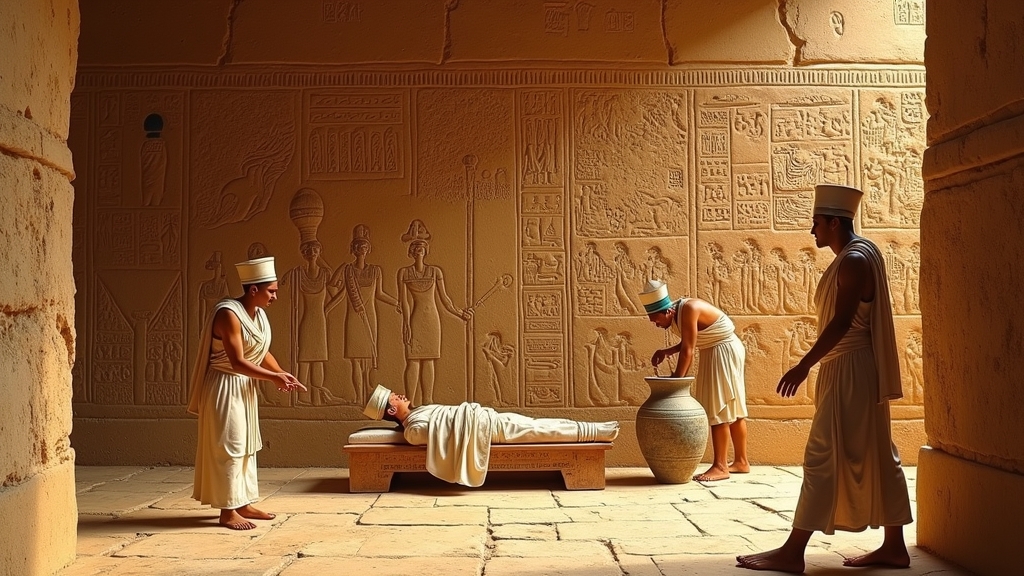Embalming is the process of keeping human remains preserved by administering chemicals to slow down the decomposition process. Usually, this is done to preserve the body for future medical use or to improve the deceased’s suitability for private and public viewing or visiting.
Embalming is frequently required when there will be a delay between the time of death and the burial or cremation. The procedure is also required when viewing or waking will be performed to remember the deceased. In this instance, additional cosmetic applications and makeup will be used, necessitating embalming as well.
This article explains all there is to know about embalming, from its history to how a person can be embalmed.
People opt for embalming for various reasons, including the following:

- When they desire more time to spend with their loved ones.
Even without embalming, you can still visit your deceased loved one in a chapel of rest, church, or private residence. However, you’ll start to observe some physiological changes in the body when people pass away roughly after a week. Embalming keeps the body of your loved one preserved, extending the time you and others can spend with them.
- When you can’t decide if you want to visit your loved one
If you’re unsure if you want to visit your loved one, embalming gives you more time to decide and typically enables you to do so up until the burial.
- When the funeral service is not held immediately
Most people don’t hold funerals immediately after death. There are many reasons for this, but one common one is when visitors pay their respects from afar. If this is the case, embalming will offer everyone a little more time to visit your loved one if you’d like them to.
- When it’s necessary to transport the deceased overseas
Depending on the context, they may be flying into or out of the U.S. This typically happens when someone is being repatriated (returned to their native country) or requests that their funeral occurs in a specific location. In these situations, the person is required by law to be embalmed.
- When you desire that the appearance of your loved one be more similar to what they looked like while alive.
Anyone viewing a loved one, whether in solitude or during a funeral with an open casket, may find this to be consoling. Embalming eliminates any sign of sickness, allowing your loved one’s corpse to look as if they were when alive.
- When your loved one’s body was hurt when they passed away
When people die from automobile accidents, parts of their bodies might be damaged. When this happens, skilled embalmers can frequently (but not always) recreate the person’s body or face, cover up their wounds, or give them a look close to their original appearance when alive.
The history of embalming around the world
Archaeologists discovered signs of artificial mummification, a sort of early embalming, as early as 5,000–6,000 BC. The Egyptians were the civilization that most likely used mummification the most, developing elaborate rites and rituals to make sure the corpse was preserved correctly.
They had the belief that the soul would someday return to the body, but only if it could discern the body to which it belonged.
The Mayans, Aztecs, Ethiopians, and Tibetan societies all used mummification and embalming to preserve the body after death. The discovery of the corpse of Xin Zhui, who passed away in China in 160 BC, revealed that the Chinese were not only practicing embalming but were also quite skilled at it. Despite being over two thousand years old, Xin Zhui’s body is still recognizable and has barely decomposed.

Embalming in Europe
Although previous civilizations viewed embalming as a cultural or religious requirement, the more dominant religions from Christianity, Islam, and Judaism had little spiritual significance for keeping the body intact after death by the Middle Ages. Preservation wasn’t necessary because people were swiftly buried after passing away most of the time.
European Crusaders that passed away in the Middle East were occasionally embalmed to varying degrees of success. In Renaissance Europe, the preservation of corpses became crucial to the advancement of science. During this time, scientists were the major people who used the embalming procedure to examine the human body. It is believed that Leonardo Da Vinci used embalming to enable him to create precise anatomical sketches.
Embalming continued to gain popularity in Europe throughout the 17th/18th centuries, primarily due to scientific rather than religious reasons. In the 1700s, a Scottish surgeon by the name of William Hunter invented embalming for burial, and John Hunter, his brother, started providing these services to the general public.
The need for long-distance travel increased in the 1800s, partly as it became more common for people to pass away from home. Embalming becomes more significant since returning home for burial grew sentimental and cultural significance.
Embalming in America
The custom of embalming first made its way across the Atlantic, not merely for research but also for burial during the American Civil War. Thousands of men died away from home and their mourning families during the Civil War due to the tremendous death and destruction it caused.
Dr. Thomas Holmes has experiments with contemporary embalming methods at the time. Colonel Elmer Ephraim Ellsworth, who was a close friend and Lincoln’s coworker was slain on May 24, 1861, while removing a Confederate flag from a Virginia hotel. Colonel Ellsworth’s remains were embalmed so that soldiers could pay their respects; the Colonel was then laid to rest at New York City Hall.
The Army Medical Corps hired Dr. Holmes to preserve Union commanders’ bodies so they might be sent back home after. As a result of the operation’s effectiveness, President Lincoln eventually approved the embalming of all Union soldiers who had died in battle. Dr. Holmes allegedly embalmed over 4,000 troops.
After his assassination in 1865, Abraham Lincoln’s corpse was preserved using this embalming technique. Several cities, including Baltimore, Philadelphia, Albany, Harrisburg, Buffalo, Cleveland, New York City, Columbus, Michigan City, Indianapolis, and Chicago, received his body by train for public viewing.
The trip took about two weeks, starting on April 21 in Washington, DC, and ending on May 3 in Springfield, Illinois, where the body was buried.
Following the Civil War, Dr. Holmes’ method of embalming had gained widespread recognition and was starting to be accepted by the general public as a respectable method of handling the dead.
Modern embalming became fully active when undertakers, rather than surgeons, started handling the responsibility as demand for embalming rose in the 1890s.
Although more contemporary ones have replaced Dr. Holmes’ methods, the concept of preserving a loved one’s corpse is still a common funeral choice in the present.
Embalming Today
Embalming involves several essential procedures. The corpse is first positioned on the mortuary table with a head block holding up the head. The embalmer then verifies the demise by looking for indicators of demise such as rigor mortis, lividity, and clouded corneas. Once that’s done, the embalming process will begin. Here are the steps funeral homes take to embalm a corpse.
The embalming process

Step 1. Getting Ready for the Body
1. First, the attendant will ensure that the body is upright. If the body is front-side down, the blood will gravitationally flow to the lowest body parts, especially the face. It may become more challenging to give the face a realistic appearance for viewers if the facial features become discolored and bloated as a result.
2. Next, they’ll take off any clothing the person wears. The body will be left exposed throughout the process so that they can examine the skin for indications that embalming is practical. They’ll also take out any IV catheters or needles that are present.
Typically, they’ll list any items found on the deceased person at this point in the embalming report, as well as any injuries, bruising, or other discolorations. The report serves as protection if the family decides to sue the funeral home for any reason.
It’s always paramount to show respect for the body. So when working, they often cover the genitalia since the family can show up anytime.
3. They’ll then cleanse any orifices, including the mouth, eyes, nose, and others. The features are cleaned both inside and out with a potent disinfectant. They’ll check the deceased to see what kind of fluid is needed need. Some embalmers will use this opportunity to prepare the procedure by mixing all the fluid they need; typically, a good dilution is 16 ounces of liquid to 2 gallons (7.6 L) of water.
4. They’ll have to shave the body to eliminate all hairs. While women and children are frequently shaved to remove stray hairs or “peach fuzz” off the face, men are typically shaved to remove facial hair and other hair.
5. The rigor mortis can be broken by stroking the body. To release tension, they’ll massage the main muscle groups and rotate stiff joints to make them more flexible. The embalming fluid will be diverted away from where it should be if the muscles are tight since this will produce extravascular pressure.
Step 2: Set the Features
1. Eye examination; the eye examination is done with extreme care. First, they close the eyes, and then a little piece of cotton is inserted between the eyelid and the eye to round out the eyelids, which often tend to droop back into their sockets. An eye cap made of plastic is occasionally used for this.
The features are established before the introduction of the embalming fluid because that solution will “set” the body quite rigidly and make it difficult to do so afterward. The eyelids are never sewed shut but can occasionally be glued shut.
2. Lock the mouth and let it settle naturally; the mouth is typically stitched shut with suture string by inserting a curved needle under the gums through the jaw and back up through the septum. The mouth form maintains the jaw’s normal alignment and bites, holding it together like a mouthguard or dental prosthetic. This approach frequently leaves less space for human mistakes.
3. Hydrating the features: For a natural and lifelike appearance, a small amount of cream is applied to the lips and eyelids to prevent them from drying out.
Step 3: Arterial embalming
1. Arterial embalming begins by identifying the incision point: This typically involves concurrently injecting embalming fluid—a mixture of formaldehyde, various chemicals, and water—into an artery while draining blood from a nearby vein or the heart; the arteries are preserved. So they’ll first choose a point of incision. In men, the incision is performed close to the base of the SCM muscle and the collarbone, and a typical body requires around two gallons of fluid to embalm. The femoral site is the most preferred choice for ladies or younger individuals.
2. Creating the incision. After preparing an entrance site and inserting the drain tube, they’ll clean the vein point and attach a ligature to the tube’s lower side. The artery is treated similarly, except instead of a drain tube, a cannula is implanted in it. They’ll then lock the cannula in place by placing the cannula forceps on the artery. Next, they clamp off the artery’s upper side with little locking forceps to stop the flow.
3. Spreading the fluid: While the body is being embalmed, it’s washed with a good germicidal/antibacterial soap, checked for drainage, and the limbs are massaged to encourage the flow of blood and embalming solution. The fluid will exert pressure on the veins as it moves through the arteries, indicating that it travels throughout the body. The veins will appear to be somewhat enlarged. The jugular drain tube is regularly opened to release pressure and let blood escape.
4. Lowering the pressure. The machine is turned off when there’s about 20 percent of the solution is left, then the cannula is turned around and injected into the opposite side of the selected artery. This will embalm the area where the cannula previously occluded. It will also embalm the lower leg in the event of the femoral and the right side of the head if the right common carotid is removed.
5. Completing the embalming: After finishing the embalming or when the fluid supply runs out, they’ll turn off the machine, take out the cannula, and tie off the veins and arteries used. The cuts would be sutured shut, sealing powder to conceal any leaks.
Step 4: Cavity embalming
1. After cleaning the arteries, it is now time to clean the interiors of the organs to prevent the buildup of bacteria and gas and the expulsion of extra fluid from the mouth or nose.
2. Performing a chest aspiration: To perform a chest aspiration, they’ll place the trocar 2 inches (5.1 cm) above the umbilicus and 2 inches (5.1 cm) to the right. Next, they’ll clear out the hollow organs, including the pancreas, small intestine, and stomach.
3. Remove air from the lower cavity: The large intestine, bladder, and, in the case of females, the uterus, are aspirated using the trocar that has been removed, turned around, and inserted into the lower body. Cotton may occasionally be stuffed into the anus and vagina to prevent seepage.
4 Inject cavity liquid into the body’s center: The hollow organs are sterilized and preserved using cavity fluid, normally 30% formaldehyde, and commonly injected using gravity.
5. After removing the trocar, they’ll use a trocar screw to seal the opening.
Step 5: Skeletonizing the Body
1. The embalmer will thoroughly wash the body to eliminate any blood or other chemicals left over from the embalming procedure. Next, they’ll thoroughly but gently wipe the body using the same disinfectant used previously.
2. Updating the features: The face will be given realistic makeup, the fingernails will be filed short, and the hair should be styled and manicured.
3. Dressing the body. The deceased’s family often chooses the attire for the casket. The body would be adequately and meticulously dressed. The deceased is best worn, plastic underwear that can shield particularly leaky bodies.
4. Placing the body into the coffin. They’ll peacefully arrange the body. Any suggestions or additional instructions regarding the presentation would be discussed with the family.
The cost of embalming
Cost is frequently a significant consideration in the decision to embalm. Even though embalmers are not required to complete the same amount of training as doctors, many people nevertheless classify them as being in the “medical” profession because of the nature of their work.

As a result, embalming can be highly expensive because the embalmers are often paid very well (though obviously not at the same level as most doctors). Families should budget at least $600 for the embalming procedure, which typically takes a mortician 2 hours to complete. Sometimes a county coroner will make numerous cuts in a body during an autopsy, and it might be expensive to fix those cuts during an embalming procedure. They typically double or triple the amount of time and effort an embalmer needs to put into a task, and as a result, the cost can also double or triple.
When an embalmer first sees a body (when it is delivered to them following an autopsy), it is possible for him or her to assess an accurate estimate of the cost of his or her services relatively quickly, but this is not usually done. Most funeral homes won’t let a family know about the added expense until after the embalming has been completed.
Families are frequently asked to sign a declaration allowing the embalmer to change the price based on problems encountered by the funeral home during the operation. It’s essential to be aware that there is no official legal authorization for this activity, and it is perfectly acceptable for a family to request a precise price quote for the service before any work is done.
The controversy around embalming
It’s possible that families considering embalming are unaware that their choice is contentious. But embalming is, to put it mildly, controversial. The goal of activists operating across the country is to make the procedure illegal eventually. Still, given how deeply established embalming practices are in American culture today, this objective is proving challenging to achieve.
These campaigners’ arguments that embalming harms the environment and the people who perform the art have also typically fallen flat. The chemicals employed in the embalming procedure have been scientifically demonstrated to decompose quickly and harmlessly once a dead person is buried. When necessary safety precautions are taken, they pose no greater threat to workers than any potentially dangerous chemical in any other workplace.
Therefore, those who oppose embalming typically wage their wars in the “court of public opinion,” trying to persuade Americans not even to consider embalming a viable option for prepping a body for burial.

This argument can become rather heated, and anyone thinking about embalming will likely run into gruesome, terrifying accounts of what embalmers actually do to a body online. An anti-embalming website regularly states in giant letters on its website, “An embalmed body bears very little relation to nature.”
A family might first be persuaded to decide against even considering embalming for a loved one, but societal standards sometimes end up convincing. In one instance, a family experienced the abrupt death of their father one evening and was forced to decide whether or not to embalm less than 24 hours later.
Being quite practical and economical in general, the family had no plan to spend more than $1,000 on the embalming procedure and was confident that the deceased would be against being embalmed.
Nevertheless, the deceased had been very kind to people with limited resources throughout his life, and several of the man’s close friends, including two who were there at his death, approached the family with adamant demands that the embalming be carried out.
It appears that the companions’ superstitious mentality raised a lot of potential issues. Without an embalming service, the guy would be able to rest in peace, but his friends would be devastated since they wouldn’t get to see their cherished friend one final time, dressed elegantly and looking his best in a casket.
The pastor at the man’s church, who is also one of the man’s friends, sensed the potential for friction. This decision over embalming may cause in his flock, and he subtly arranged for a donation to pay for the cost of embalming.
Even though the family had the money to cover the cost of the embalming, it was comforting for them to know they could order a service they were uncomfortable with and not be responsible for paying for it. And they did that out of reluctance.
The man’s friends stood and prayed in front of the body for a longer time than usual during a viewing service and during the time right before the funeral itself.
In the end, many family members concluded that, despite not aligning with their overall values, the choice to embalm had been a good one in this circumstance.
Frequently asked questions about embalming

1. What’s the objective of embalming?
There are three primary objectives for the embalming procedure:
1. Cleaning up the body.
2. Making the physique more appealing and realistic.
3. Maintaining the physique.
2. Does the law mandate embalming?
Every state has its own embalming laws and restrictions. Although most state laws do not require embalming, a body is often required to be embalmed, chilled, or stored in an odor-proof container within 48 hours following death.
Under the Funeral houses and crematories are required to let families know that embalming is not necessary for some situations.
3. What are the benefits of embalming?
Embalming offers two key advantages. It gives you additional time to prepare the body for cremation, burial, or long-distance transportation. This might be highly advantageous because it would give family and friends more time to travel great distances to view the remains and pay their respects. It might also be necessary to preserve a body for a doctor’s examination.
The aesthetics of the corpse is the second significant benefit. Embalming gives the body a more natural appearance, which might be useful for loved ones who want to see the body it was before he or she died.
4. What are the cons of embalming?
The risks linked to the chemicals used in embalming are the main drawbacks. This applies explicitly to funeral home employees as these chemicals are risky for embalmers.
Despite being biodegradable, embalming fluid is nonetheless seen as a pollutant that needs to be buried and disposed of throughout the embalming procedure. Thankfully, safety protocols and personal protective equipment shield embalmers from these risks.
Another drawback is the cost of embalming. This will increase funeral expenses overall, which may be a deterrent.
5. Does cremation necessitate embalming?
Most of the time, simple cremation or prompt burial do not require embalming. This is because these procedures are carried out immediately after death, without a funeral. A funeral home or crematory may demand to embalm if the family decides to hold a public viewing or gather with the body before the burial or cremation.
6. How long can a body be embalmed?
The sorts of chemicals employed in the fluid, the quantity of fluid utilized, and the overall conditions in which the body is kept all affect how long an embalmed body won’t decompose. Depending on the type of material used, embalmed bodies placed in caskets allows the body to last for many years.
7. What is the cost of embalming?
As mentioned above, funeral homes and crematories typically charge for both the embalming procedure and other preparations and care of the corpse. Therefore, the cost of embalming is typically in 2 parts.
The cost covers sanitizing, restorative art to restore natural form and color, hairdressing, dressing, cosmetology, and casketing, or placing the deceased’s remains in a casket.
Request a General Price List (GPL) from the funeral home or crematory you are arranging services with for a breakdown of these prices.
8. Who gets to make the embalming decisions?
The deceased may have specified whether they wanted to be embalmed. If there is no preplanning contract or if the person who has passed did not designate, the person who possesses the right of disposition under state law (the deceased’s next-of-kin) will have the right to decide. Otherwise, it will be up to the family’s discretion.
9. Is embalming prohibited by some religious or cultural practices?
Although embalming is a very popular procedure, several religious and cultural traditions forbid it and other forms of preparation and care for the dead.
Ask the religious leader at your place of worship if embalming is a permitted method of body preservation if you’re unsure. A funeral director will cooperate with you to meet your religious and/or cultural needs, following your state’s embalming rules.
10. What changes does a body undergo after applying the embalming chemicals?
Embalming momentarily postpones the initial processes of decomposition, which start to tear down our body tissues the instant we die.
Embalmment fluids that are no longer being circulated by the body are drained and replaced throughout the embalming process with a combination of preservation chemicals.
11. Are organs removed during embalming?
Although the essential organs were removed and preserved during embalming by the Ancient Egyptians, this is not the case anymore. Unless the deceased was an organ donor, their corpse would be preserved while their organs were still within.
The organs may be taken out and weighed during a post-mortem to determine the cause of death. But they are reinstalled inside the body cavity before the body leaves the mortuary.
12. What is the alternative to embalming?
While refrigeration is the typical alternative to embalming, not all funeral homes have these amenities. If a viewing is required, the corpse might need to be embalmed if the funeral home has an embalming machine to offer embalming services but don’t have a cooling facilities. Some mausoleums can also require embalming. If you choose not to embalm the deceased’s remains, you may want to check this policy, which the mausoleum has simply adopted.
